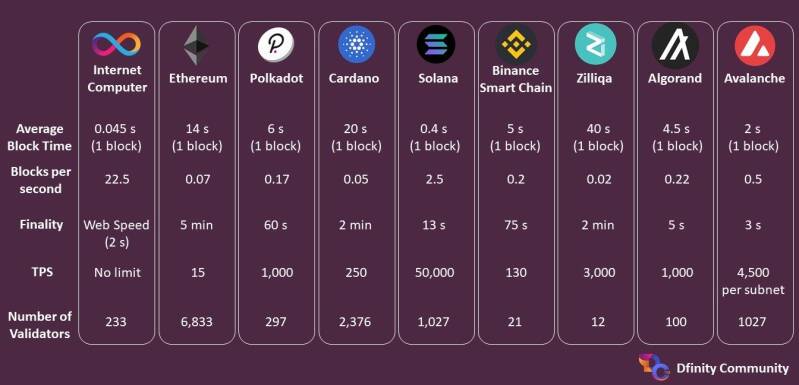
The Solana blockchain is a development of the original bitcoin blockchain. In this blog I will take you through the technology of the Solana blockchain. How does it work and what's new? How is this blockchain different from other, more well-known blockchains?
What is the Solana blockchain?
Very briefly, the Solana blockchain is defined as follows:
Solana is a decentralized blockchain built to enable scalable, user-friendly apps for the world.
In itself, every blockchain is decentralized and every blockchain wants to build scales and user-friendly apps. In the blockchain world you also see more and more projects that want to increase scalability and build user-friendly apps via smart contracts. Solana is therefore one of the competitors of the other blockchain projects like Bitcoin blockchain and Ethereum.
Solana is one of the fastest blockchains in the world. That is, Solana is one of the blockchains that can process many transactions per second. Solana's ecosystem is also growing steadily with around 400 projects already operating on .
How does the Solana blockchain works?
1. Proof of History (PoH).
Solana is currently the only, or one of the few blockchains that uses the Proof of History (PoH) consensus algorithm. What is unique about this consensus mechanism is that a unique timestamp is created on the transaction. This protocol ensures that time is the verifier in transactions, allowing for efficient and lightning-fast transactions.
Elon Musk shared on Twitter in September 2021, "Time is the ultimate currency," and chances are he's talking about Solana here.
Read more about the PoH here or the white paper if you want to dive more into the technology.
2. Tower BFT
The pBFT is based on the Practical Byzantine Fault Tolerance theory, as first published in 1999.
The advantage of the pBFT is that they do not have to search through a variety of processes, consistently optimizing transaction speed. The pBFT is an incredibly interesting concept.
The pBFT in brief:
In order to provide aliveness, replicas must move to a new view, if they are unable to execute a request. However, it is important to maximize the period of time, when at least 2f + 1 non-faulty replicas are in the same view, and to ensure that this period of time increases exponentially until some requested operation executes.
Read more about the BFT here.
3. Gulf Stream
The GUlf Stream allows the blockchain to achieve an incredibly high transaction speed. On the Solana blockchain, approximately 50,000 transactions take place every second.
The Gulf Stram protocol ensures that all transactions are cached. The transactions are stored at different levels and then forwarded to the edge of the network. As a result, validators work ahead, so to speak, dramatically reducing requirements on memory and confirmation time.
This form of storing and verifying transactions is unique. This is also known as the "mempool management''. The mempool can be thought of as a kind of queue. Each node builds its own queue. If a transaction comes along that needs to be verified on the blockchain, it can be verified and stored in the mempool. In the queue, this transaction is taken by a miner, who can verify it on the blockchain.
4. Sealevel
The sealevel works closely with the previous point. Sealevel allows Solana to switch horizontally with GPUs (Graphics processing unit) and SSDs (Solid-state drive is a new generation of storage device used in computers. SSDs use flash-based memory).
5. Turbine
Turbine is supposed to solve the scalability problem.
Through this protocol, it is possible to break down the processes into smaller steps, making data transfer easier. The purpose of this is to increase the transaction speed.
6. Pipelining
Pipelining is not a new technique or procedure. This concept is also used in designing the CPUs. By assigning all transactions coming in through the pipeline to the appropriate hardware, the transaction can be validated faster. You then no longer have to find where that transaction needs to go to be verified or operated on a transaction-by-transaction basis, as in an app or game. When you start a game, the information from the game is forwarded to the correct hardware on your computer, which can then start the game in a smooth manner. This same concept applies to blockchain.

7. Archivers
When we talk about storing data, archivers are very important. The validators of the Solana blockchain ensure that data is stored correctly (the Archivers). These are just normal computers and laptops where this information is stored.
8. Cloudbreak
In cloudbreak, the structure of the Solana database is important. Cloudbreak allows the database to be read and edited while working closely with the above protocols (such as Pipelining and Archivers).

Solana vs the rest
The Solana network is one of the few platforms that offers a TPS (transactions per second) above 1,000. Also, the is the network is very scalable.
Compared to Bitcoin which uses the proof of work consensus mechanism, Bitcoin can handle far fewer transactions per second than Solana.
In addition, Solana has a block time, which is the time it takes to verify a new block on the blockchain. With Solana, that is 600 milliseconds! Solana charges $0.00025 per transaction, which is super cheap compared to Ethereum that has issues with the scalability and transaction fees (with the Merge the transaction costs are reduced to 'normal').



Reactie plaatsen
Reacties